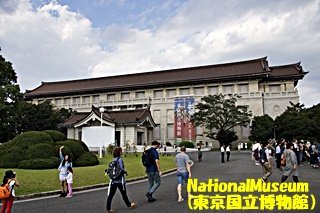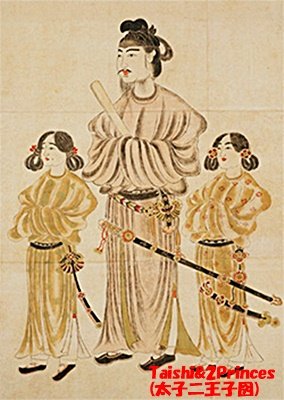Nara has three Wolrld Heritage sites. One is Nara-Park area,
8 spots already explained in presious posts. Second is Horyuji
in Ikaruga near Asuka village. Third one is Yoshino one of the
best place in Japan to enjoy cherry blossom, which will be the
subject in the following post.
奈良には世界遺産が三か所あります。 既に詳細をご紹介の、市の中心部
奈良公園の一帯と、斑鳩の法隆寺、それと熊野古道で伊勢にも繋がる、桜
の名所”吉野”一帯です。
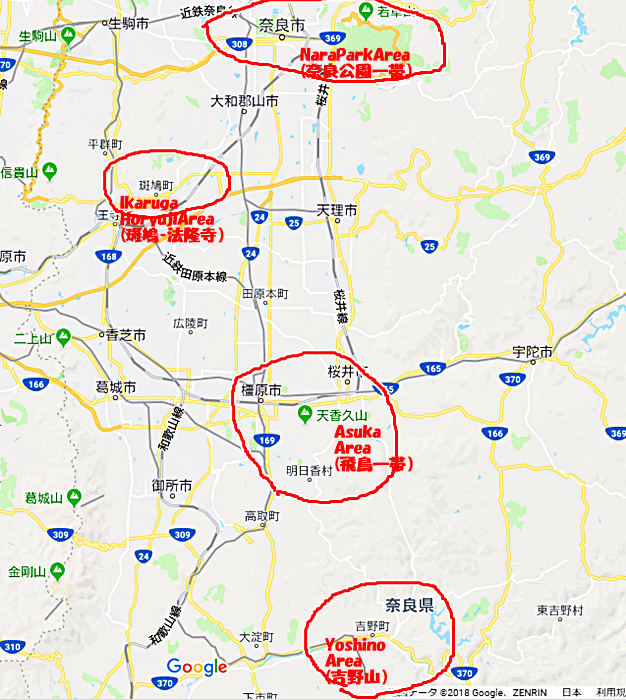
Horyuji built in 607 is very much attached to ShotokuTaishi
(Prince Shotoku) and school name of the temple is Shotoku.
As written before, Prince Shotoku is a sort of "Idol" in Japanese
history, especially in relation to Buddhism or Shinto-Buddism
for mental basis of Japanese, and his figure was even employed
as the first design of 10000 yen bill.
After TeibiWar in 587, between Soga and Mononobe clans, he built
Shitennouji in Naniwa, issued Imperial Edict to promote Buddhism,
built IkarugaKyu (origin of Horyuji), made rules of 12 colors of
caps of ranks, Japan's first written code of laws of 17 articles
(Constitution), and so forth for peace of the society assisting
Imperial Suiko. He is said to have commuted from Asuka to Ikaruga
until 605 and moved and set up his office at Horyuji from 607.
He also gave lectures and authored writings relating to Buddism
including SankyoGisyo (Commentary on Sutra of Hokke, Shoman and
Yuima) which is National Treasure, to try to enlighten public at
that time.
法隆寺は607年、推古天皇の摂政だった聖徳太子(574~622年)により
創建とされます。 587年丁未の乱(蘇我‐物部氏)で崇仏派が勝利、
聖徳太子は四天王寺建立(592)、仏教興隆の詔(594)等、仏教の興隆
を図り、斑鳩宮建立(601)し冠位十二階(603)~十七条憲法(604)等
政務は飛鳥から毎日通って行っていたと伝えられる。 605年からは
斑鳩に移り住み、607年に法隆寺を建立、622年に亡くなるまで、三経義疏
を著す等仏教啓蒙にも努め、日本での仏教の基礎を固めた。
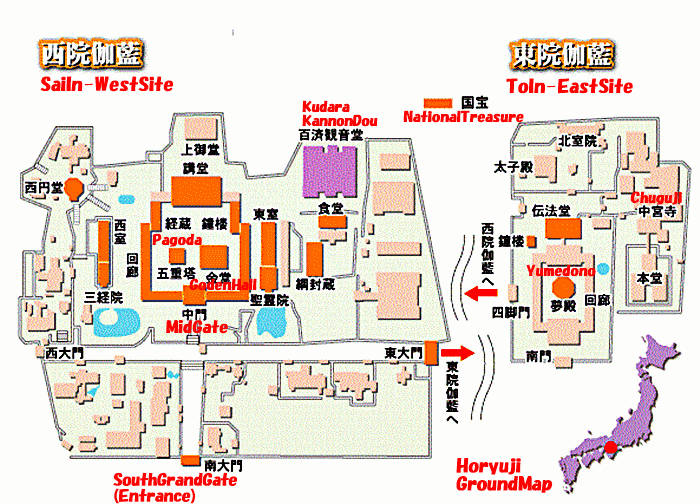
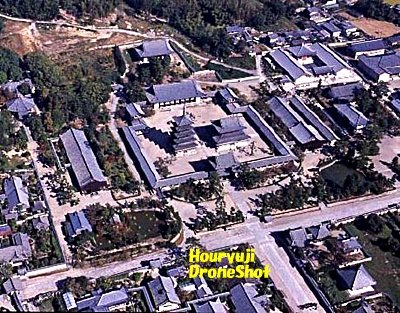
Horyuji is consist of Sai-in(west) including Kin-do and Five-storied
Pagoda both National Treasures and To-in(east) mainly octagon shaped
"Yumedono" . Most of edifices of Horyuji were built in Asuka~Nara
period and oldest wooden construction in the world which are designated
National Treasures. On top of constructions, Horyuji keeps many old
Buddhist images and Buddhism crafts of National Treasures.
As in attached ground map, in addition to Yumedono, east site has
Chuguji ShotokuTaishi built to worship the Bodhi of his mother, while
between east and west site, there is DaiHoZoDen (Treasure Warehouse),
which built in 1941 to exhibit temple's treasures, but the role was
transferred to DaiHoZoIn, including Kudara-Kannnon hall, East treasure
warehouse and West treasure waresouse, when they were completed in
- DaiHoZoDen is used for the annual exhibition in spring and fall
of temple's treasures usally not opened. Three temples, namely Horyuji,
a bit north of Horyuji, Horinji and Hokkiji is called "Ikaruga Three
Temples.
法隆寺は金堂・五重塔を中心の西院と夢殿を中心の東院から成り、西院伽藍
は世界最古の木造建築物群であり、法起寺と共に1993年日本初の世界遺産に
登録されている。 伽藍以外にも、飛鳥・奈良時代の仏像、仏教工芸品等
多数の文化財を有する。 概略の地図は下記の通りで、東院北側には中宮寺
があり、中間には大宝蔵殿があります。 大宝蔵殿は1941年寺宝公開の為
建設ですが、現在は大宝蔵院(百済観音堂・東宝殿・西宝殿)が1998年に
完成、そちらに宝蔵の位置は譲っており、春秋の法隆寺秘宝展として、通常
拝観出来ない宝物の展示を行っています。 中宮寺は聖徳太子の母の菩提を
弔う大和を代表する尼寺ですが、更に少し北の法輪寺と法起寺(世界遺産)
は法隆寺とも縁の深い寺で、三つの寺を合わせて”斑鳩三寺”とも言われて
います。
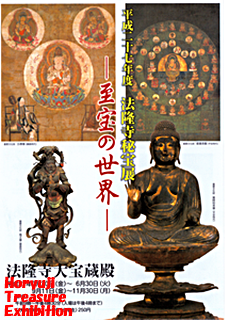

After ShotokuTaishi had passed away, his son YamaShiroNoOooeNoOu was
forced to kill himself by Soga-Iruka, who built Horinji to worship his
father ShotokuTaishi and also Hokkiji which had been the villa of Shotoku-
Taishi. Hokkiji is the National Treasure and its three storied pagoda
is the oldest one in Japan.
Horyuji keeps many Ntional Treasure rank treasures apart from the
constructions, as KudaraKannonZou used as a japanese stamp, KannonBosatu
Zou in Yumedono which is said to be the life-size of ShotokuTWaishi,
Miniature Shrine of Beetle Design and so forth.
Horyuji groud is wide and 17 National Treasures and 35 Cultural Properties
are spread to large site plus many Buddhism images and crafts requiring
many hours to look around.
聖徳太子没後、息子の山背大兄王は、蘇我入鹿によって自害に追い込まれる
が、斑鳩三寺の法輪寺は山背大兄王が太子を偲んで創建、法起寺は聖徳太子の
別荘だったものを、山背大兄王が寺にしたとのことです。
法隆寺には伽藍の建物以外にも、数多くの国宝級の宝物が保存されていますが、
中でも切手になっている、百済観音像、夢殿の観音菩薩立像、玉虫厨子等が
特に有名です。 大宝蔵院及びタイミングが合えば、大宝蔵殿での秘宝展
をご覧頂ければと思います。
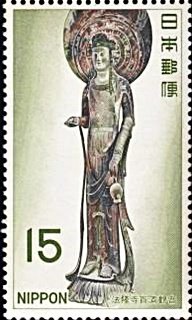
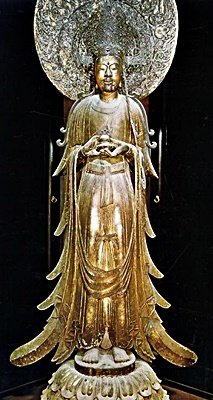
It might be wise to think of the following courses for observation in
a short hours;
Mainly Sai-In (west site), Kindo and Five storied Pagoda are both
National Treasure and oldest wooden buildings in the world. Kindo has
Buddha three images, which is considered to be ShotokuTaishi life size
and other many Buddhust images. Pagoda probably provides feeling of
1300 years of history and at first story, in each east, west, north and
west side, there are separate clay figures of "Yuima-Monju"(east),
"Separation of Buddha's ashes"(west), "Maitreya Land"(south) and "Nirvana"
(north) . There seem to include figures of human bodies with animal heads.
法隆寺は敷地も広く、建造物も国宝17件、重文が35件、更に仏像・仏具の
殆どが飛鳥・白鳳・天平時代の作で、全部を短時間で見て回るのは無理です。
そこで、お薦めのコースを下記してみます;
第一のコースは西院伽藍の中心で、世界最古の木造建築の、金堂と五重塔を
巡るコースです。 金堂には聖徳太子の等身像と言われる、国宝釈迦三尊像
を初め、多数の仏像が安置されています。 五重塔は1300年の歴史の重みを
感じさせてくれますが、初層には東西南北に塑像群が置かれていて、東が
維摩詰像土(維摩が文殊を問い詰める)、西が分舎利仏土(釈迦の分骨図)
南に弥勒仏像土(弥勒浄土図)、北が有名な泣き仏の涅槃浄土(釈迦涅槃)
の配置で、一部人間の身体で顔は動物の像もあるそうです。
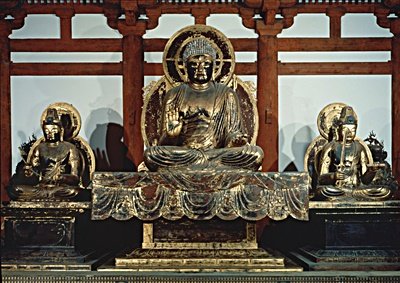
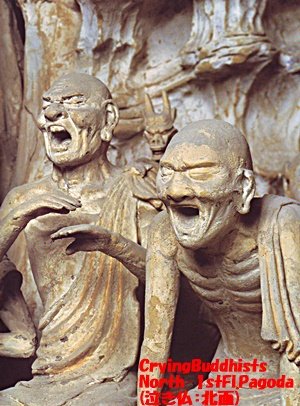
Sai-In but only DaiHoZoInm treasure warehouses, KudaraKannonDo, ToHoDen
(east treasure earehouse) and SaiHoDen (west treasure warehouse).
Those warehouses display National Treasure of Kannon Bosatsu Statue of
"Kudara Kannon", "Yumetagai Kannon" and "Kyuumen Kannon" and also Jizo-
Bosatsu Statue, which is only the National Treasure of JizoBosatsu Statue.
第二のコースは金堂・五重塔の東側に建つ大宝蔵院です。 百済観音堂、
東宝殿、西宝殿の三つで、国宝の観音菩薩立像(百済観音‐切手になって
いる)、同名ですが九面観音、同じく夢違観音、地蔵菩薩立像(地蔵菩薩
としては唯一の国宝)等が安置されている。
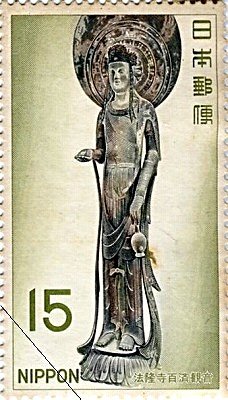
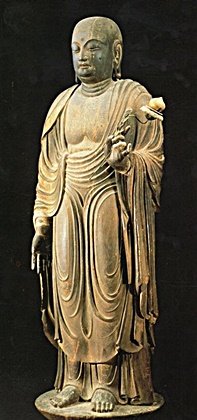
Unique hexagon Yumedono of To-In (east site) course, which exhibits "Guze
Kannon" which is said to be life-size of Shotokutaishi and the representative
symbol of Horyuji. Yumedono was built at the dwelling site of ShotokuTaishi
and family, as the memorial construction of the Price. Chuguji was built
by ShotokuTaishi at different site, which transferred to present site in
late 16th century when the nunnery became "Monzeki" the head nun is from Royal
family. Chuguji also has National Treasure of Bosatsu Hankazou, which is
the image of sitting Bodhisattava in meditation and which is similar to the
famous one at KoRyuJi in Kyoto said to be granted by ShotokuTaishi.
第三のコースは夢殿(聖徳太子信仰の中心)を中心に東院をい巡るコース
です。 八角円堂の夢殿には、太子等身とされる救世観音像は法隆寺の
代表・象徴とも言えるかと思います。 時期が合えば、春秋に大宝蔵殿
での公開も見ものです。 時間があれば、東院の北側にある中宮寺にも
京都広隆寺で聖徳太子が授けたとされる、有名な弥勒菩薩半跏像と比較
される、国宝の木造菩薩半跏像もあります。 また、前述の法起寺の
日本最古と言われる三重塔も国宝です。
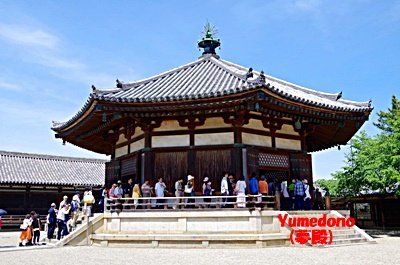

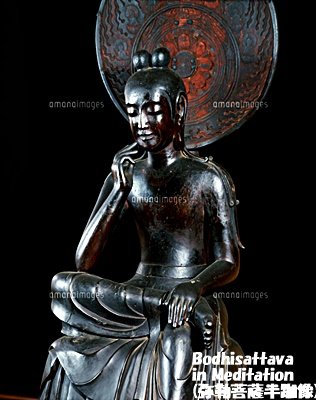
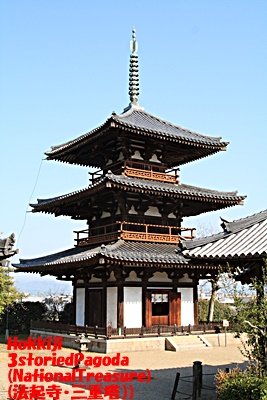
Finally I would add another group of Horyuji treasures in Tokyo, which were
originally conceded to Emperor at the time of "HaibutuKisyaku" (Anti and aboish
Buddhism movement in Meiji Period) to avoid impair and damage to them. At that
tme Emperor granted money to Horyuji to cover the cost of repairing many buildings
and treasures which helped to enable to keep the present conditions of them.
最後に、東京の国立博物館(上野)の法隆寺宝物館に皇室御物の太子‐
二王子像や法華義疏を含む320件近い宝物が保存されている。 これらは
明治の廃物毀釈に当たり、法隆寺が賢明にも1878年に皇室に献納し、
代わりに下賜された金で、伽藍や堂宇の修理等に充てて現在の姿を維持
出来たというわけです。
